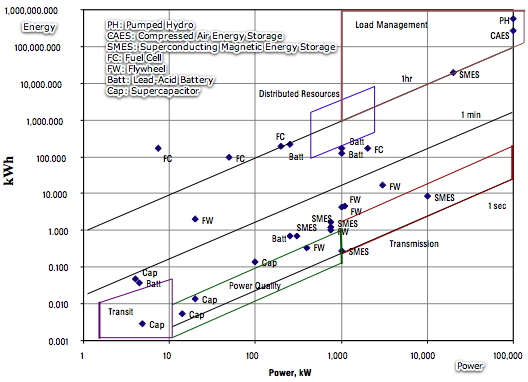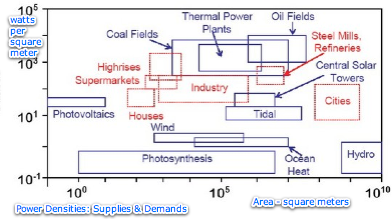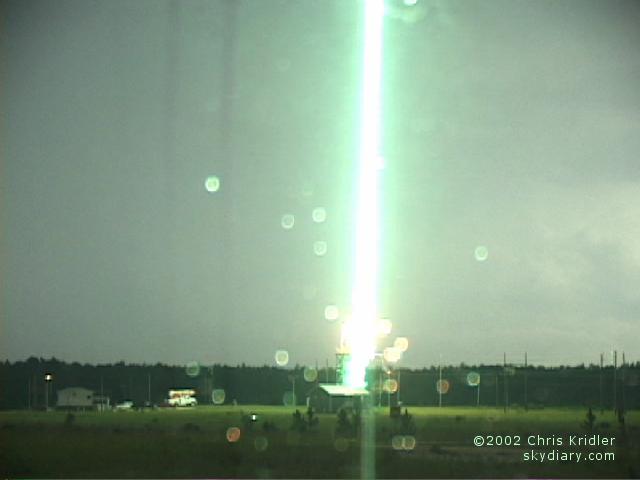There is a delightful state just before sleep, but it requires a certain absence of anxiety. A place where threads in your head can intermingle in amusing ways. Last night I spent some moments there and cloud servers became entangled with the density of energy storage. I’m liking the idea that server farms in isolated venues convert low value electricity into high value byte streams, much like an aluminum smelter converting cheap power into energy dense aluminum foil. A unit for information goods: watts/byte. I see server farms beyond the cloud, in orbit, drawing disintermediated power straight from the sun.
Category Archives: energy storage
Energy Storage Choices
This chart is pulled from a good report (pdf) circa 2001 out of Sandia National Labs which is full of nice charts like this one. Energy storage systems have numerous facets you can sort them out over. For example up-front costs, lifetime, cost per cycle, etc. etc. This shows seven different technologies, including superconducting magnets (which I must say do threaten to take the fun-geeky crown from fly wheels). It doesn’t include some very viable and useful storage tech, including sodium batteries, flow batteries, phase change materials such as ice used for daily load leveling, etc. It would be better yet if those were on here, as well as some others that are a bit off to one side; like a train load of coal or a typical LNG tank.

The these are scattered over two metrics. How much power the tech can supply and how much total the tech can store. It’s a shame that there aren’t points in all four corners. I guess the sun kind-a-sort-a goes up above the upper left corner. I assume the dots show existing systems and there large practical areas around those points.
One of the metrics not shown is the maturity of the technology and the market. SMES looks like it’s close or just past solving the major tech-maturity questions. I enjoyed, for example, a fun essay about using the magnets pulled from old medical scanners for energy storage. CAES is ready to build out large market share; but as of yet there aren’t a lot of existing systems. Flywheels are even further along and look like they have lots of potential for sales in the next few years. PH is probably tapped out – i.e. fully built out, at least in the industrialized countries.
Regions of the chart are delimited and labeled to show what applications fall into that region. As the entire system comes under increasing stress power quality applications are going to get a lot of capital. Load management is quite a range of problems: balancing daily load, weekly to monthy variations in solar and wind sources, and seasonal variations from demand or distribution bottlenecks.
Power Density
This chart is lifted, and slightly edited, from a post discussing how much land area it’s going to take to generate power from wind or solar. No surprise there, fossil fuels are amazingly dense sources of energy.
In any case the horizontal axis is showing how large various things are. There isn’t really anything surprising along that axis. Hydro systems are large, solar panels are small. Cities are bigger than houses! The red regions are demand energy, the blue regions are ways of supply in. The vertical axis shows how concentrated the flux of energy flowing in or out is. Oil fields and power plants have very dense energy flows; while plants and hydro-electric impoundment areas don’t.

This suggests that one big change that will come if we step back from fossil fuels is a change in which side of the energy distribution system consumes the most real estate. Right now 10 to 100 times more real estate is used on the demand side, and afterwards it might be 10 times more on the supply side. That is quite a flip.
I love this kind of chart, i.e. big broad overviews.
Power Spikes
 Energy Storage is a means to smooth out intermittent power supplies or demands. It lets you shift the power from one time period to another. It lets you create a distribution system which sized for average load rather than peak load. The more isolated your power system the more you need all these. The electric power industry calls isolated systems island grids.
Energy Storage is a means to smooth out intermittent power supplies or demands. It lets you shift the power from one time period to another. It lets you create a distribution system which sized for average load rather than peak load. The more isolated your power system the more you need all these. The electric power industry calls isolated systems island grids.
The book I’m reading describes an island with abundant power, via hydro, but lousy power due to local industry’s intermittent and high power requirements. So lousy that they were importing fuel to run generators just to raise that quality. In that case fly wheels were the solution. There are a few subway systems that take the power spikes from breaking trains and store them into flywheels to put back into the system when the next train starts up. There’s a huge flywheel at a mine in Alaska that buffers 5 megawatts of power every few minutes as a drag line they have jerks about.
Thinking about power spikes got be thinking about extreme cases. That’s natural for me since I presume that most sources of supply and demand have a very skewed distribution. For example the book includes an example of capturing power spikes from high wind gusts (which are quite skewed) by using fly wheels on an island off the coast of Japan. I wonder how large a spike that system can grab before it let’s it pass. Presumably it isn’t designed to absorb abundant energy from the few huge storms the island probably experiences every year. So there are power spikes the system is designed to survive rather than harvest. Which given the nature of highly skewed distributions means that a lot of the power goes untapped. Your typical wind power system harvests only the long tail of the wind, but not the elite wind.
So I got to wondering about lightning strikes. There is some great nutter material on the web about that. For example at the always amusing site “half bakery” there is a suggestion to running the lightning into an underground cavern and using it to melt tungsten. I love all these crazy ideas; particularly one that mix together other enthusiasms: kites, space elevators, or super conductors.
Poking around looking at these amusing ideas led me to this outrageous gimmick: a solution to an age old problem, the tendency for lightning to never strike twice in the same place. Lightning rockets! You shoot a rocket into the storm trailing behind it either a wire or a conductive smoke trail. That’s fun to think about, but it’s much more fun to watch the short video!.
Iowa Stored Energy Park
For some reason I’ve become interested in energy storage. I seem to be thinking that storage is the nub of solving the problem of peak oil (et. al).
So, currently I’m reading Energy Storage: A Nontechnical Guide (isbn, worldcat) which was published in 2006. It’s a fun book for a geek. Fun, like reading popular science but a bit more serious. It focus is on the electric utility industry and it’s working premise is that something is about to happen in that industry which parallels a switch which occurred in the natural gas industry a few years back. The natural gas industry was deregulated so that a number of elements of the distribution system, storage included, were broken out in ways that created a bloom of different markets. The author Richard Baxter states that both before and after this change the natural gas industry managed to limit the cost and extent of new distribution pipelines because they used storage as a way to smooth load.
Un-bundling creates distinct markets for lots of different qualities. For example an electric distribution system needs to keep everything running at 60 Hertz, and some of these storage systems are useful for archiving that. Dependable steady power is another quality and these systems enable variable demand (such as daily or seasonal variation), variable supply (such as wind or tidal power), or distribution bottlenecks to be smoothed over. And then there is the usual buy low sell high scenarios where the storage systems enable market timing. The point is that these systems have lots of value generating scenarios that one might not notice at first blush.
There are only two schemes for storing huge amounts of energy; hydro and compressed air. The compressed air systems push the air into an underground storage cavity, usually a salt dome. Which is nice since they are easier to get permits for in developed regions, as contrasted with hydro-systems that sit on top of scenic mountain tops. I was surprised that the compressed air systems are implemented as complements to natural gas powered generating stations. Apparently a natural gas power generating station needs a lot of air, and it wants it under pressure; so absent a source of compressed air it spends some of it’s output to compress the air – 66% of it’s output!
Which brings us to this marvelous hack – the Iowa Stored Energy Park. This place deals in four kinds of energy. It has a large wind farm. It has a large compressed energy store. It has a large natural gas store. It makes electricity. The result is a marvel of arbitrage opportunities. Buying and selling across numerous markets. For example profiting on seasonal volitility in the natural gas markets. While at first blush you might think this thing is about smoothing out the wind energy produced by their wind farm I suspect that only time will tell what aspects of the operation are the most valuable. Baxter points out that there are profitable scenarios where compressed-air/natural gas electricity producers run both the compressors and the generators at the same time to selling frequency stabilization services. I suspect that their own wind farm is a demonstration, than that they can sell a smoothing service to all the other wind farms in the region.
Of course from here on in I’m going to think of my laptop battery as an energy park and yearn for a compressed air version.